ICT301: Enterprise Architecture Management Plan for Dell University
VerifiedAdded on 2022/08/26
|25
|5786
|25
Report
AI Summary
This report presents a comprehensive Enterprise Architecture Management Plan for Dell, a major player in the IT industry. The report is structured into three key parts: EA Program Management, EA Current Architecture Summary, and EA Future Architecture Summary. Part 1 focuses on governance, principles, strategy support, roles, responsibilities, budget, and performance measures. Part 2 provides an overview of Dell's current state, detailing strategic goals, business services, systems, applications, technology infrastructure, IT security, EA standards, and workforce requirements. Part 3 outlines future operation scenarios, planning assumptions, updates to current and future views, a sequencing plan, and configuration management to guide Dell's architectural evolution. The report emphasizes the importance of aligning IT infrastructure with business strategies, improving efficiency, and reducing costs to achieve Dell's objectives. It also includes the budget and performance measures to ensure effective implementation.
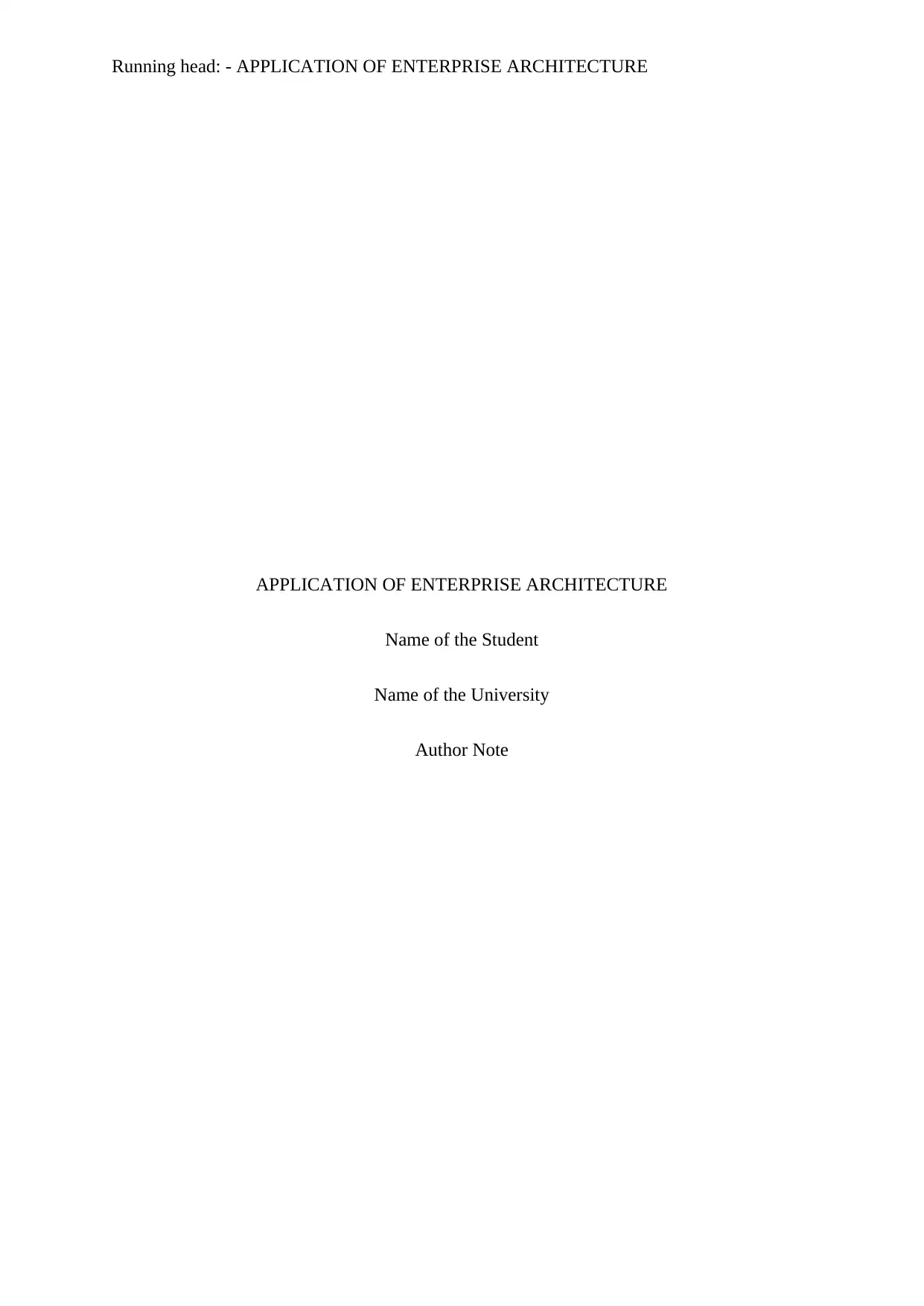
Running head: - APPLICATION OF ENTERPRISE ARCHITECTURE
APPLICATION OF ENTERPRISE ARCHITECTURE
Name of the Student
Name of the University
Author Note
APPLICATION OF ENTERPRISE ARCHITECTURE
Name of the Student
Name of the University
Author Note
Paraphrase This Document
Need a fresh take? Get an instant paraphrase of this document with our AI Paraphraser
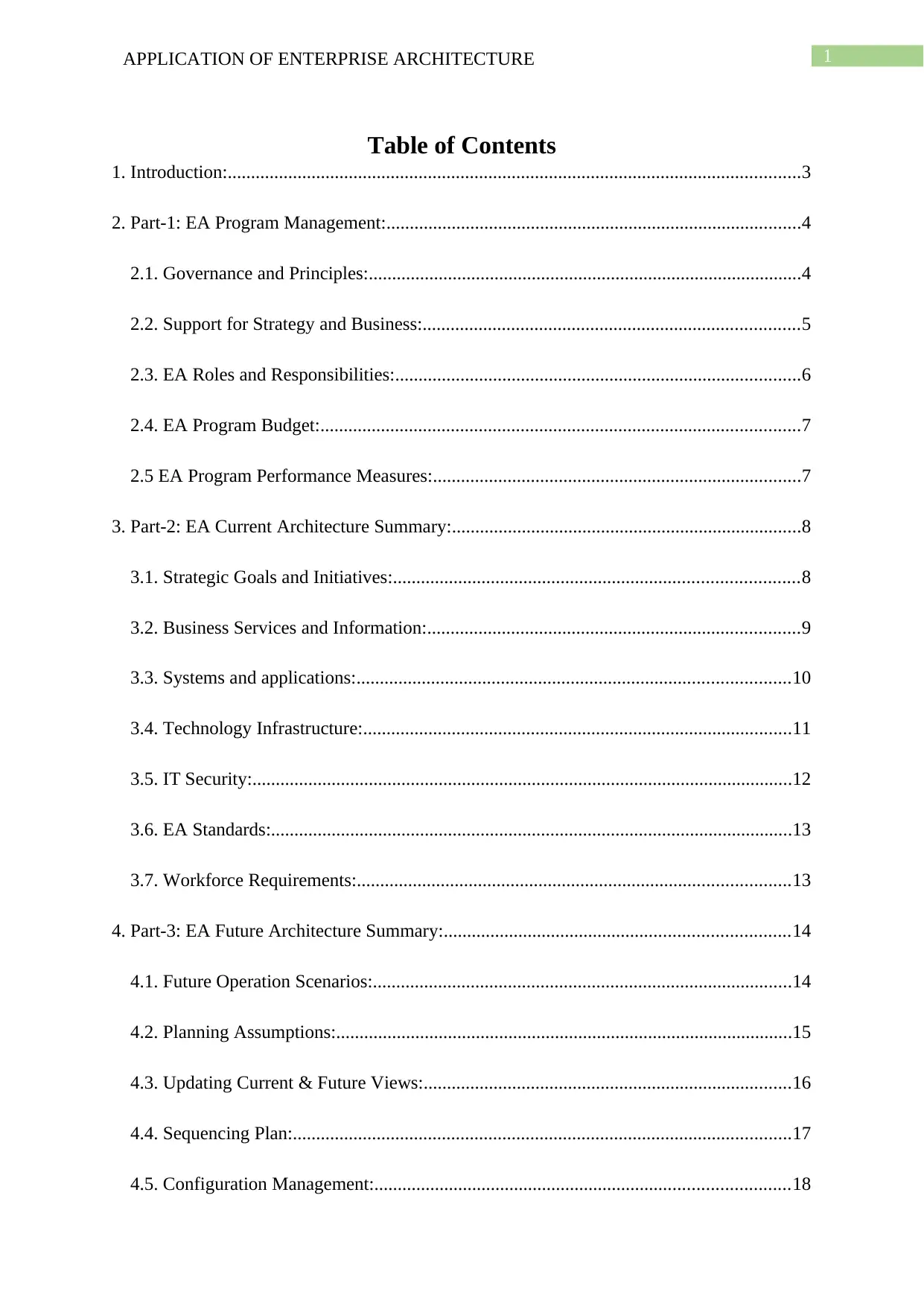
1APPLICATION OF ENTERPRISE ARCHITECTURE
Table of Contents
1. Introduction:...........................................................................................................................3
2. Part-1: EA Program Management:.........................................................................................4
2.1. Governance and Principles:.............................................................................................4
2.2. Support for Strategy and Business:.................................................................................5
2.3. EA Roles and Responsibilities:.......................................................................................6
2.4. EA Program Budget:.......................................................................................................7
2.5 EA Program Performance Measures:...............................................................................7
3. Part-2: EA Current Architecture Summary:...........................................................................8
3.1. Strategic Goals and Initiatives:.......................................................................................8
3.2. Business Services and Information:................................................................................9
3.3. Systems and applications:.............................................................................................10
3.4. Technology Infrastructure:............................................................................................11
3.5. IT Security:....................................................................................................................12
3.6. EA Standards:................................................................................................................13
3.7. Workforce Requirements:.............................................................................................13
4. Part-3: EA Future Architecture Summary:..........................................................................14
4.1. Future Operation Scenarios:..........................................................................................14
4.2. Planning Assumptions:..................................................................................................15
4.3. Updating Current & Future Views:...............................................................................16
4.4. Sequencing Plan:...........................................................................................................17
4.5. Configuration Management:.........................................................................................18
Table of Contents
1. Introduction:...........................................................................................................................3
2. Part-1: EA Program Management:.........................................................................................4
2.1. Governance and Principles:.............................................................................................4
2.2. Support for Strategy and Business:.................................................................................5
2.3. EA Roles and Responsibilities:.......................................................................................6
2.4. EA Program Budget:.......................................................................................................7
2.5 EA Program Performance Measures:...............................................................................7
3. Part-2: EA Current Architecture Summary:...........................................................................8
3.1. Strategic Goals and Initiatives:.......................................................................................8
3.2. Business Services and Information:................................................................................9
3.3. Systems and applications:.............................................................................................10
3.4. Technology Infrastructure:............................................................................................11
3.5. IT Security:....................................................................................................................12
3.6. EA Standards:................................................................................................................13
3.7. Workforce Requirements:.............................................................................................13
4. Part-3: EA Future Architecture Summary:..........................................................................14
4.1. Future Operation Scenarios:..........................................................................................14
4.2. Planning Assumptions:..................................................................................................15
4.3. Updating Current & Future Views:...............................................................................16
4.4. Sequencing Plan:...........................................................................................................17
4.5. Configuration Management:.........................................................................................18
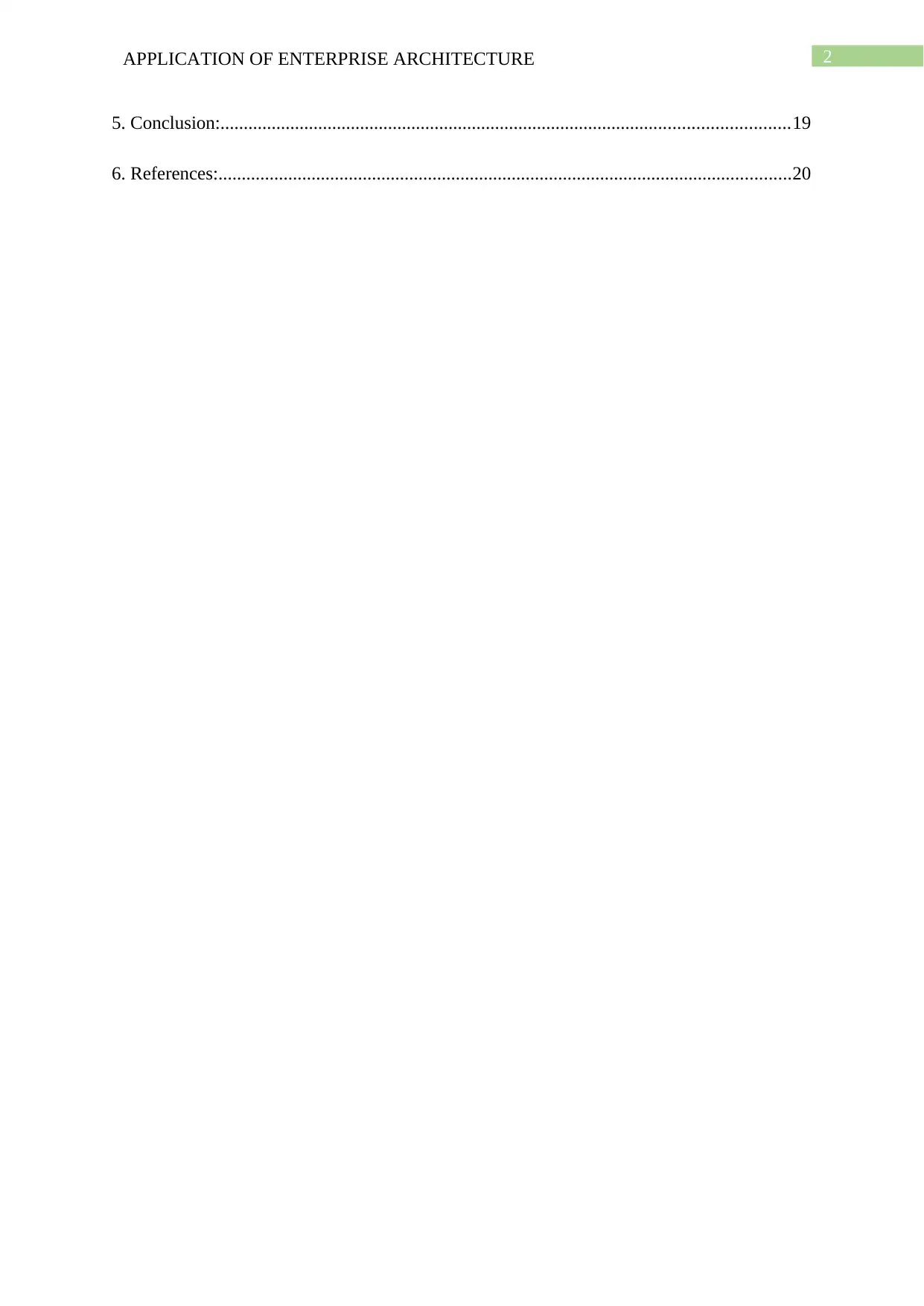
2APPLICATION OF ENTERPRISE ARCHITECTURE
5. Conclusion:..........................................................................................................................19
6. References:...........................................................................................................................20
5. Conclusion:..........................................................................................................................19
6. References:...........................................................................................................................20
⊘ This is a preview!⊘
Do you want full access?
Subscribe today to unlock all pages.

Trusted by 1+ million students worldwide
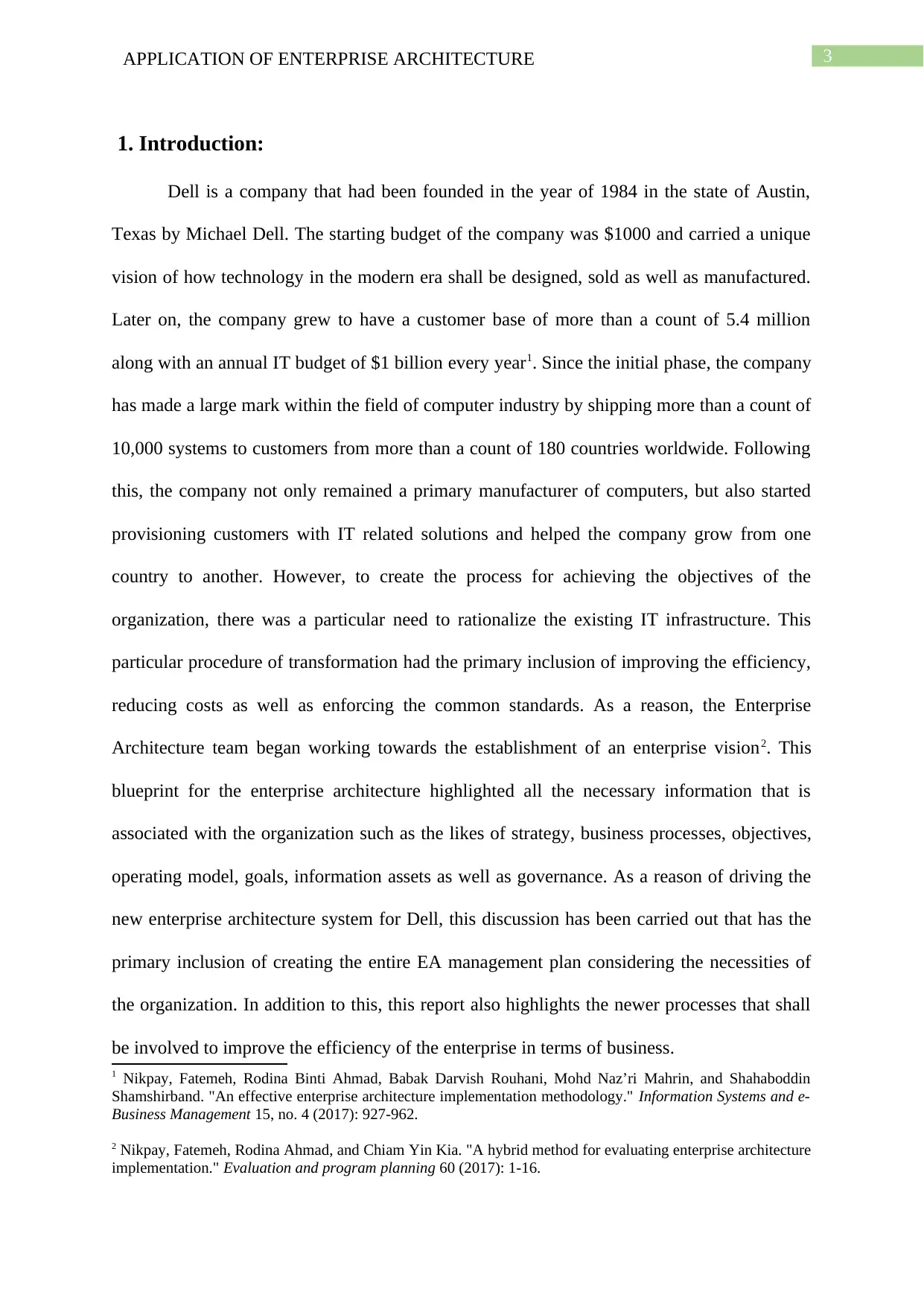
3APPLICATION OF ENTERPRISE ARCHITECTURE
1. Introduction:
Dell is a company that had been founded in the year of 1984 in the state of Austin,
Texas by Michael Dell. The starting budget of the company was $1000 and carried a unique
vision of how technology in the modern era shall be designed, sold as well as manufactured.
Later on, the company grew to have a customer base of more than a count of 5.4 million
along with an annual IT budget of $1 billion every year1. Since the initial phase, the company
has made a large mark within the field of computer industry by shipping more than a count of
10,000 systems to customers from more than a count of 180 countries worldwide. Following
this, the company not only remained a primary manufacturer of computers, but also started
provisioning customers with IT related solutions and helped the company grow from one
country to another. However, to create the process for achieving the objectives of the
organization, there was a particular need to rationalize the existing IT infrastructure. This
particular procedure of transformation had the primary inclusion of improving the efficiency,
reducing costs as well as enforcing the common standards. As a reason, the Enterprise
Architecture team began working towards the establishment of an enterprise vision2. This
blueprint for the enterprise architecture highlighted all the necessary information that is
associated with the organization such as the likes of strategy, business processes, objectives,
operating model, goals, information assets as well as governance. As a reason of driving the
new enterprise architecture system for Dell, this discussion has been carried out that has the
primary inclusion of creating the entire EA management plan considering the necessities of
the organization. In addition to this, this report also highlights the newer processes that shall
be involved to improve the efficiency of the enterprise in terms of business.
1 Nikpay, Fatemeh, Rodina Binti Ahmad, Babak Darvish Rouhani, Mohd Naz’ri Mahrin, and Shahaboddin
Shamshirband. "An effective enterprise architecture implementation methodology." Information Systems and e-
Business Management 15, no. 4 (2017): 927-962.
2 Nikpay, Fatemeh, Rodina Ahmad, and Chiam Yin Kia. "A hybrid method for evaluating enterprise architecture
implementation." Evaluation and program planning 60 (2017): 1-16.
1. Introduction:
Dell is a company that had been founded in the year of 1984 in the state of Austin,
Texas by Michael Dell. The starting budget of the company was $1000 and carried a unique
vision of how technology in the modern era shall be designed, sold as well as manufactured.
Later on, the company grew to have a customer base of more than a count of 5.4 million
along with an annual IT budget of $1 billion every year1. Since the initial phase, the company
has made a large mark within the field of computer industry by shipping more than a count of
10,000 systems to customers from more than a count of 180 countries worldwide. Following
this, the company not only remained a primary manufacturer of computers, but also started
provisioning customers with IT related solutions and helped the company grow from one
country to another. However, to create the process for achieving the objectives of the
organization, there was a particular need to rationalize the existing IT infrastructure. This
particular procedure of transformation had the primary inclusion of improving the efficiency,
reducing costs as well as enforcing the common standards. As a reason, the Enterprise
Architecture team began working towards the establishment of an enterprise vision2. This
blueprint for the enterprise architecture highlighted all the necessary information that is
associated with the organization such as the likes of strategy, business processes, objectives,
operating model, goals, information assets as well as governance. As a reason of driving the
new enterprise architecture system for Dell, this discussion has been carried out that has the
primary inclusion of creating the entire EA management plan considering the necessities of
the organization. In addition to this, this report also highlights the newer processes that shall
be involved to improve the efficiency of the enterprise in terms of business.
1 Nikpay, Fatemeh, Rodina Binti Ahmad, Babak Darvish Rouhani, Mohd Naz’ri Mahrin, and Shahaboddin
Shamshirband. "An effective enterprise architecture implementation methodology." Information Systems and e-
Business Management 15, no. 4 (2017): 927-962.
2 Nikpay, Fatemeh, Rodina Ahmad, and Chiam Yin Kia. "A hybrid method for evaluating enterprise architecture
implementation." Evaluation and program planning 60 (2017): 1-16.
Paraphrase This Document
Need a fresh take? Get an instant paraphrase of this document with our AI Paraphraser
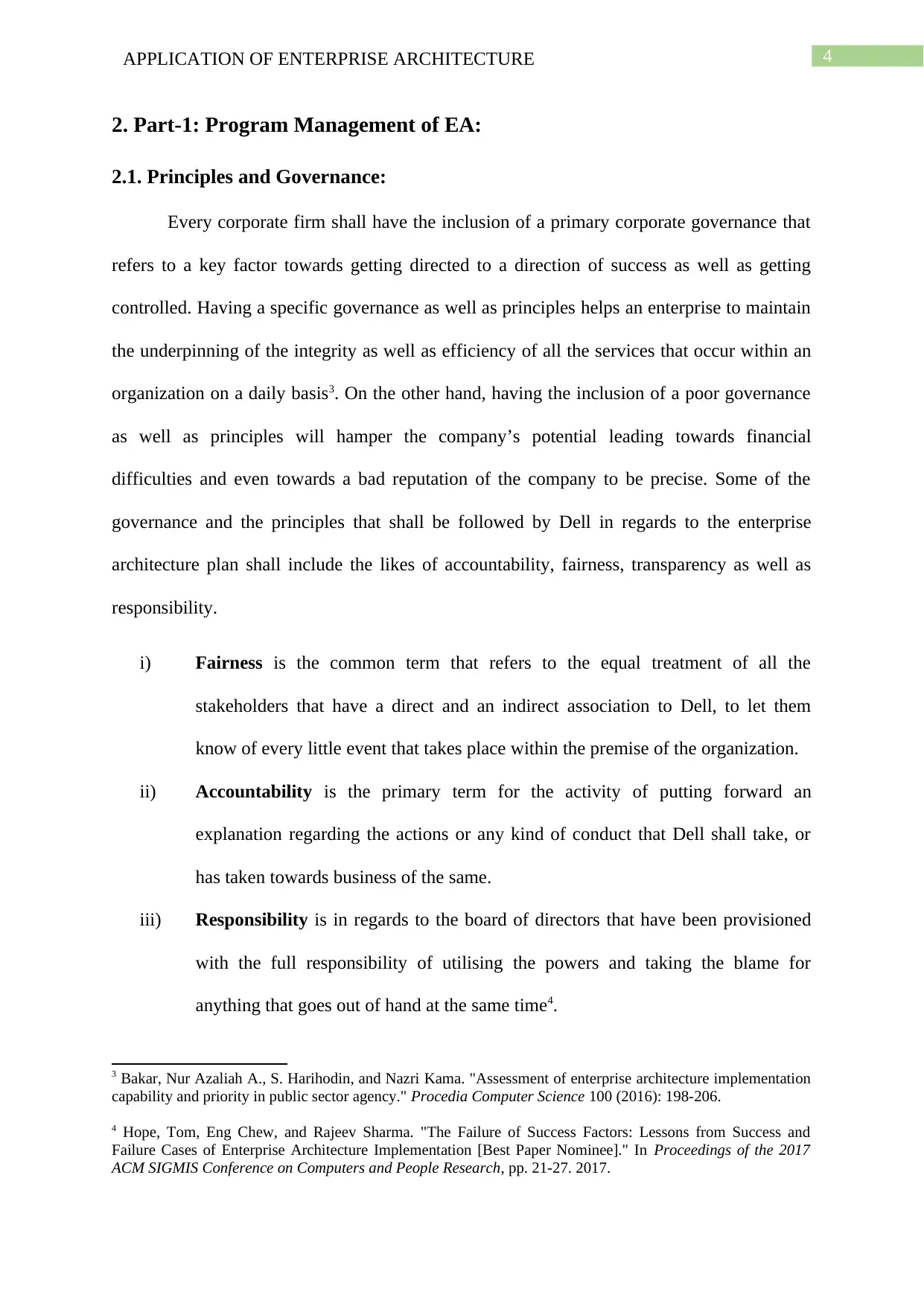
4APPLICATION OF ENTERPRISE ARCHITECTURE
2. Part-1: Program Management of EA:
2.1. Principles and Governance:
Every corporate firm shall have the inclusion of a primary corporate governance that
refers to a key factor towards getting directed to a direction of success as well as getting
controlled. Having a specific governance as well as principles helps an enterprise to maintain
the underpinning of the integrity as well as efficiency of all the services that occur within an
organization on a daily basis3. On the other hand, having the inclusion of a poor governance
as well as principles will hamper the company’s potential leading towards financial
difficulties and even towards a bad reputation of the company to be precise. Some of the
governance and the principles that shall be followed by Dell in regards to the enterprise
architecture plan shall include the likes of accountability, fairness, transparency as well as
responsibility.
i) Fairness is the common term that refers to the equal treatment of all the
stakeholders that have a direct and an indirect association to Dell, to let them
know of every little event that takes place within the premise of the organization.
ii) Accountability is the primary term for the activity of putting forward an
explanation regarding the actions or any kind of conduct that Dell shall take, or
has taken towards business of the same.
iii) Responsibility is in regards to the board of directors that have been provisioned
with the full responsibility of utilising the powers and taking the blame for
anything that goes out of hand at the same time4.
3 Bakar, Nur Azaliah A., S. Harihodin, and Nazri Kama. "Assessment of enterprise architecture implementation
capability and priority in public sector agency." Procedia Computer Science 100 (2016): 198-206.
4 Hope, Tom, Eng Chew, and Rajeev Sharma. "The Failure of Success Factors: Lessons from Success and
Failure Cases of Enterprise Architecture Implementation [Best Paper Nominee]." In Proceedings of the 2017
ACM SIGMIS Conference on Computers and People Research, pp. 21-27. 2017.
2. Part-1: Program Management of EA:
2.1. Principles and Governance:
Every corporate firm shall have the inclusion of a primary corporate governance that
refers to a key factor towards getting directed to a direction of success as well as getting
controlled. Having a specific governance as well as principles helps an enterprise to maintain
the underpinning of the integrity as well as efficiency of all the services that occur within an
organization on a daily basis3. On the other hand, having the inclusion of a poor governance
as well as principles will hamper the company’s potential leading towards financial
difficulties and even towards a bad reputation of the company to be precise. Some of the
governance and the principles that shall be followed by Dell in regards to the enterprise
architecture plan shall include the likes of accountability, fairness, transparency as well as
responsibility.
i) Fairness is the common term that refers to the equal treatment of all the
stakeholders that have a direct and an indirect association to Dell, to let them
know of every little event that takes place within the premise of the organization.
ii) Accountability is the primary term for the activity of putting forward an
explanation regarding the actions or any kind of conduct that Dell shall take, or
has taken towards business of the same.
iii) Responsibility is in regards to the board of directors that have been provisioned
with the full responsibility of utilising the powers and taking the blame for
anything that goes out of hand at the same time4.
3 Bakar, Nur Azaliah A., S. Harihodin, and Nazri Kama. "Assessment of enterprise architecture implementation
capability and priority in public sector agency." Procedia Computer Science 100 (2016): 198-206.
4 Hope, Tom, Eng Chew, and Rajeev Sharma. "The Failure of Success Factors: Lessons from Success and
Failure Cases of Enterprise Architecture Implementation [Best Paper Nominee]." In Proceedings of the 2017
ACM SIGMIS Conference on Computers and People Research, pp. 21-27. 2017.
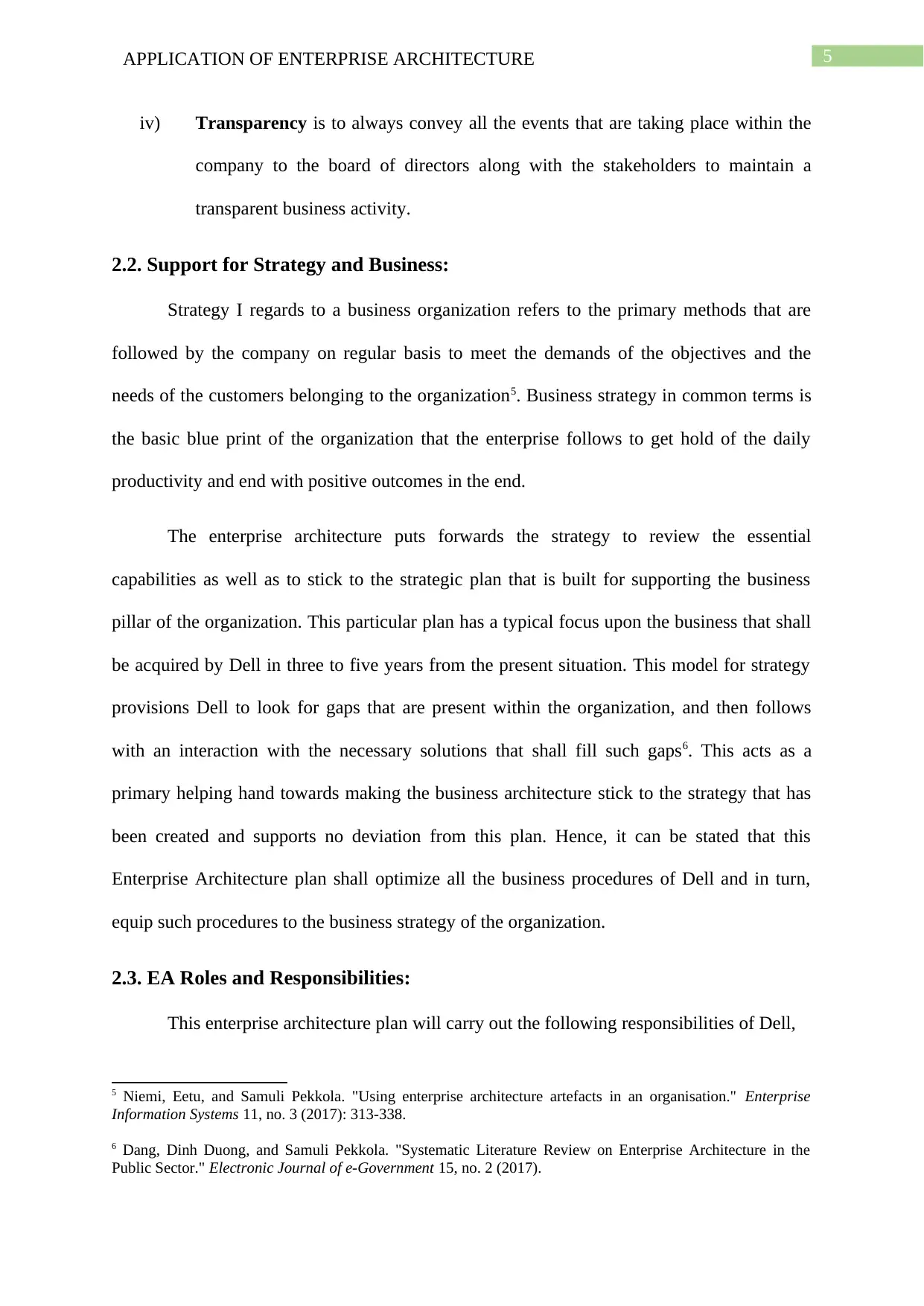
5APPLICATION OF ENTERPRISE ARCHITECTURE
iv) Transparency is to always convey all the events that are taking place within the
company to the board of directors along with the stakeholders to maintain a
transparent business activity.
2.2. Support for Strategy and Business:
Strategy I regards to a business organization refers to the primary methods that are
followed by the company on regular basis to meet the demands of the objectives and the
needs of the customers belonging to the organization5. Business strategy in common terms is
the basic blue print of the organization that the enterprise follows to get hold of the daily
productivity and end with positive outcomes in the end.
The enterprise architecture puts forwards the strategy to review the essential
capabilities as well as to stick to the strategic plan that is built for supporting the business
pillar of the organization. This particular plan has a typical focus upon the business that shall
be acquired by Dell in three to five years from the present situation. This model for strategy
provisions Dell to look for gaps that are present within the organization, and then follows
with an interaction with the necessary solutions that shall fill such gaps6. This acts as a
primary helping hand towards making the business architecture stick to the strategy that has
been created and supports no deviation from this plan. Hence, it can be stated that this
Enterprise Architecture plan shall optimize all the business procedures of Dell and in turn,
equip such procedures to the business strategy of the organization.
2.3. EA Roles and Responsibilities:
This enterprise architecture plan will carry out the following responsibilities of Dell,
5 Niemi, Eetu, and Samuli Pekkola. "Using enterprise architecture artefacts in an organisation." Enterprise
Information Systems 11, no. 3 (2017): 313-338.
6 Dang, Dinh Duong, and Samuli Pekkola. "Systematic Literature Review on Enterprise Architecture in the
Public Sector." Electronic Journal of e-Government 15, no. 2 (2017).
iv) Transparency is to always convey all the events that are taking place within the
company to the board of directors along with the stakeholders to maintain a
transparent business activity.
2.2. Support for Strategy and Business:
Strategy I regards to a business organization refers to the primary methods that are
followed by the company on regular basis to meet the demands of the objectives and the
needs of the customers belonging to the organization5. Business strategy in common terms is
the basic blue print of the organization that the enterprise follows to get hold of the daily
productivity and end with positive outcomes in the end.
The enterprise architecture puts forwards the strategy to review the essential
capabilities as well as to stick to the strategic plan that is built for supporting the business
pillar of the organization. This particular plan has a typical focus upon the business that shall
be acquired by Dell in three to five years from the present situation. This model for strategy
provisions Dell to look for gaps that are present within the organization, and then follows
with an interaction with the necessary solutions that shall fill such gaps6. This acts as a
primary helping hand towards making the business architecture stick to the strategy that has
been created and supports no deviation from this plan. Hence, it can be stated that this
Enterprise Architecture plan shall optimize all the business procedures of Dell and in turn,
equip such procedures to the business strategy of the organization.
2.3. EA Roles and Responsibilities:
This enterprise architecture plan will carry out the following responsibilities of Dell,
5 Niemi, Eetu, and Samuli Pekkola. "Using enterprise architecture artefacts in an organisation." Enterprise
Information Systems 11, no. 3 (2017): 313-338.
6 Dang, Dinh Duong, and Samuli Pekkola. "Systematic Literature Review on Enterprise Architecture in the
Public Sector." Electronic Journal of e-Government 15, no. 2 (2017).
⊘ This is a preview!⊘
Do you want full access?
Subscribe today to unlock all pages.

Trusted by 1+ million students worldwide
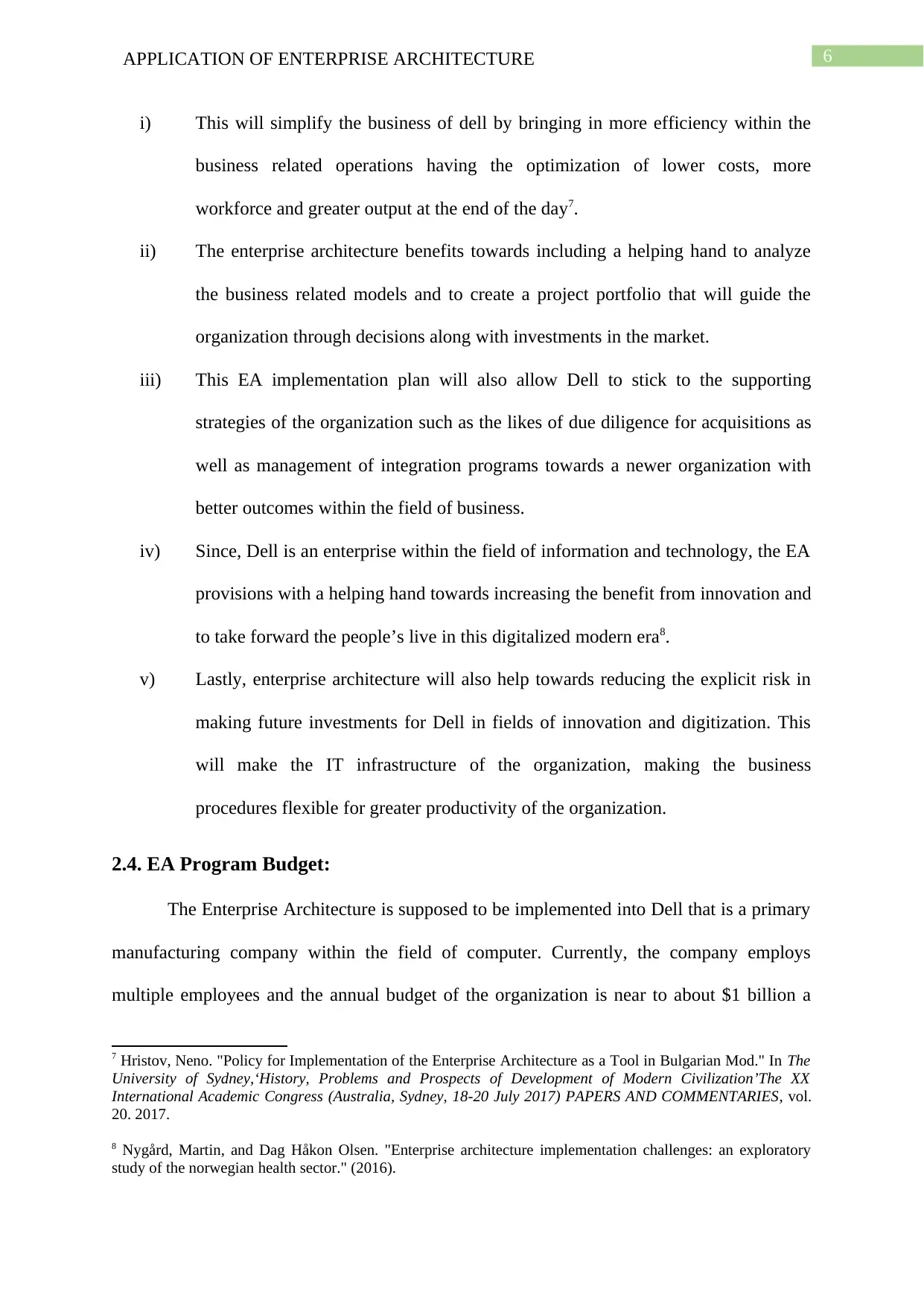
6APPLICATION OF ENTERPRISE ARCHITECTURE
i) This will simplify the business of dell by bringing in more efficiency within the
business related operations having the optimization of lower costs, more
workforce and greater output at the end of the day7.
ii) The enterprise architecture benefits towards including a helping hand to analyze
the business related models and to create a project portfolio that will guide the
organization through decisions along with investments in the market.
iii) This EA implementation plan will also allow Dell to stick to the supporting
strategies of the organization such as the likes of due diligence for acquisitions as
well as management of integration programs towards a newer organization with
better outcomes within the field of business.
iv) Since, Dell is an enterprise within the field of information and technology, the EA
provisions with a helping hand towards increasing the benefit from innovation and
to take forward the people’s live in this digitalized modern era8.
v) Lastly, enterprise architecture will also help towards reducing the explicit risk in
making future investments for Dell in fields of innovation and digitization. This
will make the IT infrastructure of the organization, making the business
procedures flexible for greater productivity of the organization.
2.4. EA Program Budget:
The Enterprise Architecture is supposed to be implemented into Dell that is a primary
manufacturing company within the field of computer. Currently, the company employs
multiple employees and the annual budget of the organization is near to about $1 billion a
7 Hristov, Neno. "Policy for Implementation of the Enterprise Architecture as a Tool in Bulgarian Mod." In The
University of Sydney,‘History, Problems and Prospects of Development of Modern Civilization’The XX
International Academic Congress (Australia, Sydney, 18-20 July 2017) PAPERS AND COMMENTARIES, vol.
20. 2017.
8 Nygård, Martin, and Dag Håkon Olsen. "Enterprise architecture implementation challenges: an exploratory
study of the norwegian health sector." (2016).
i) This will simplify the business of dell by bringing in more efficiency within the
business related operations having the optimization of lower costs, more
workforce and greater output at the end of the day7.
ii) The enterprise architecture benefits towards including a helping hand to analyze
the business related models and to create a project portfolio that will guide the
organization through decisions along with investments in the market.
iii) This EA implementation plan will also allow Dell to stick to the supporting
strategies of the organization such as the likes of due diligence for acquisitions as
well as management of integration programs towards a newer organization with
better outcomes within the field of business.
iv) Since, Dell is an enterprise within the field of information and technology, the EA
provisions with a helping hand towards increasing the benefit from innovation and
to take forward the people’s live in this digitalized modern era8.
v) Lastly, enterprise architecture will also help towards reducing the explicit risk in
making future investments for Dell in fields of innovation and digitization. This
will make the IT infrastructure of the organization, making the business
procedures flexible for greater productivity of the organization.
2.4. EA Program Budget:
The Enterprise Architecture is supposed to be implemented into Dell that is a primary
manufacturing company within the field of computer. Currently, the company employs
multiple employees and the annual budget of the organization is near to about $1 billion a
7 Hristov, Neno. "Policy for Implementation of the Enterprise Architecture as a Tool in Bulgarian Mod." In The
University of Sydney,‘History, Problems and Prospects of Development of Modern Civilization’The XX
International Academic Congress (Australia, Sydney, 18-20 July 2017) PAPERS AND COMMENTARIES, vol.
20. 2017.
8 Nygård, Martin, and Dag Håkon Olsen. "Enterprise architecture implementation challenges: an exploratory
study of the norwegian health sector." (2016).
Paraphrase This Document
Need a fresh take? Get an instant paraphrase of this document with our AI Paraphraser
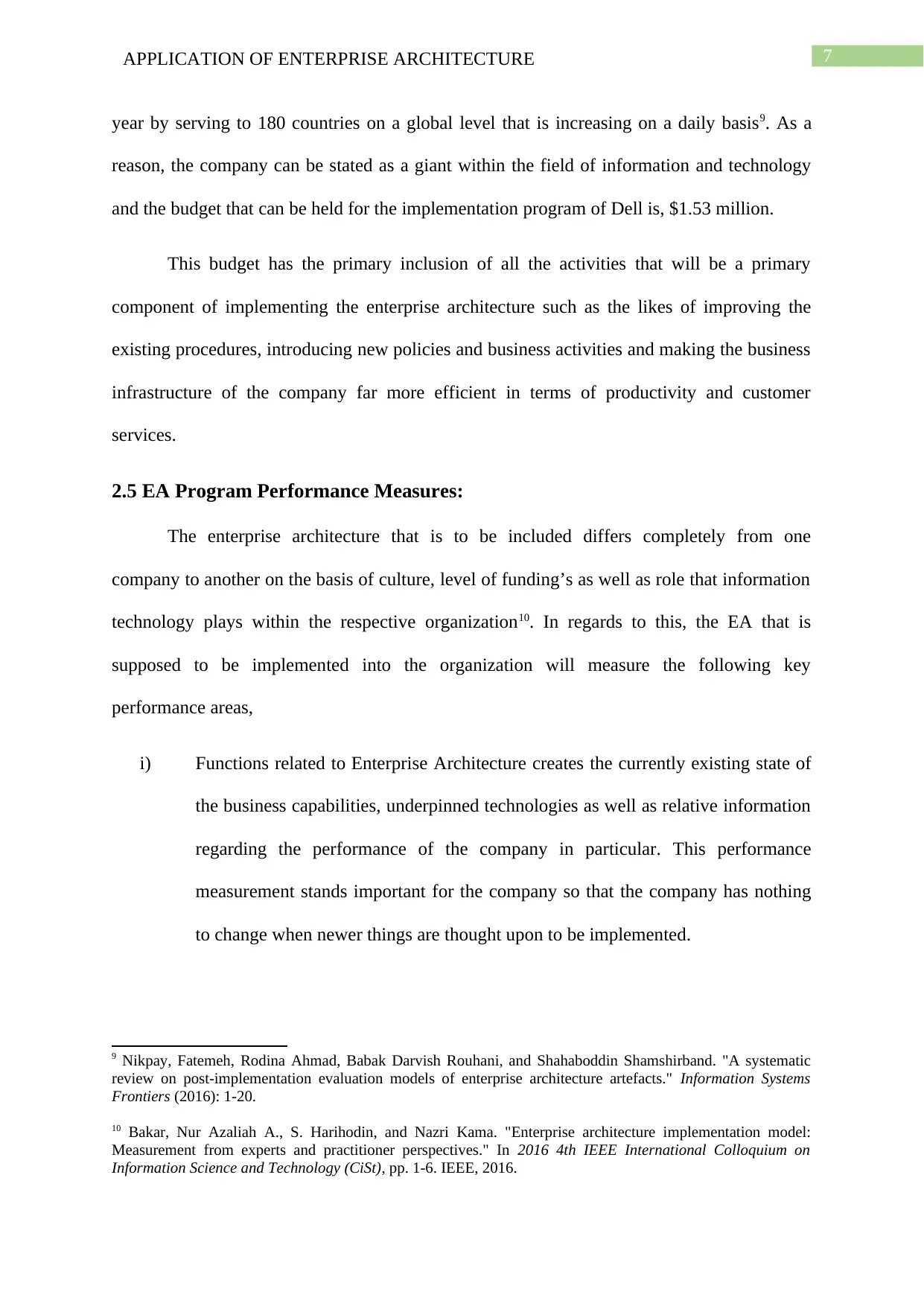
7APPLICATION OF ENTERPRISE ARCHITECTURE
year by serving to 180 countries on a global level that is increasing on a daily basis9. As a
reason, the company can be stated as a giant within the field of information and technology
and the budget that can be held for the implementation program of Dell is, $1.53 million.
This budget has the primary inclusion of all the activities that will be a primary
component of implementing the enterprise architecture such as the likes of improving the
existing procedures, introducing new policies and business activities and making the business
infrastructure of the company far more efficient in terms of productivity and customer
services.
2.5 EA Program Performance Measures:
The enterprise architecture that is to be included differs completely from one
company to another on the basis of culture, level of funding’s as well as role that information
technology plays within the respective organization10. In regards to this, the EA that is
supposed to be implemented into the organization will measure the following key
performance areas,
i) Functions related to Enterprise Architecture creates the currently existing state of
the business capabilities, underpinned technologies as well as relative information
regarding the performance of the company in particular. This performance
measurement stands important for the company so that the company has nothing
to change when newer things are thought upon to be implemented.
9 Nikpay, Fatemeh, Rodina Ahmad, Babak Darvish Rouhani, and Shahaboddin Shamshirband. "A systematic
review on post-implementation evaluation models of enterprise architecture artefacts." Information Systems
Frontiers (2016): 1-20.
10 Bakar, Nur Azaliah A., S. Harihodin, and Nazri Kama. "Enterprise architecture implementation model:
Measurement from experts and practitioner perspectives." In 2016 4th IEEE International Colloquium on
Information Science and Technology (CiSt), pp. 1-6. IEEE, 2016.
year by serving to 180 countries on a global level that is increasing on a daily basis9. As a
reason, the company can be stated as a giant within the field of information and technology
and the budget that can be held for the implementation program of Dell is, $1.53 million.
This budget has the primary inclusion of all the activities that will be a primary
component of implementing the enterprise architecture such as the likes of improving the
existing procedures, introducing new policies and business activities and making the business
infrastructure of the company far more efficient in terms of productivity and customer
services.
2.5 EA Program Performance Measures:
The enterprise architecture that is to be included differs completely from one
company to another on the basis of culture, level of funding’s as well as role that information
technology plays within the respective organization10. In regards to this, the EA that is
supposed to be implemented into the organization will measure the following key
performance areas,
i) Functions related to Enterprise Architecture creates the currently existing state of
the business capabilities, underpinned technologies as well as relative information
regarding the performance of the company in particular. This performance
measurement stands important for the company so that the company has nothing
to change when newer things are thought upon to be implemented.
9 Nikpay, Fatemeh, Rodina Ahmad, Babak Darvish Rouhani, and Shahaboddin Shamshirband. "A systematic
review on post-implementation evaluation models of enterprise architecture artefacts." Information Systems
Frontiers (2016): 1-20.
10 Bakar, Nur Azaliah A., S. Harihodin, and Nazri Kama. "Enterprise architecture implementation model:
Measurement from experts and practitioner perspectives." In 2016 4th IEEE International Colloquium on
Information Science and Technology (CiSt), pp. 1-6. IEEE, 2016.
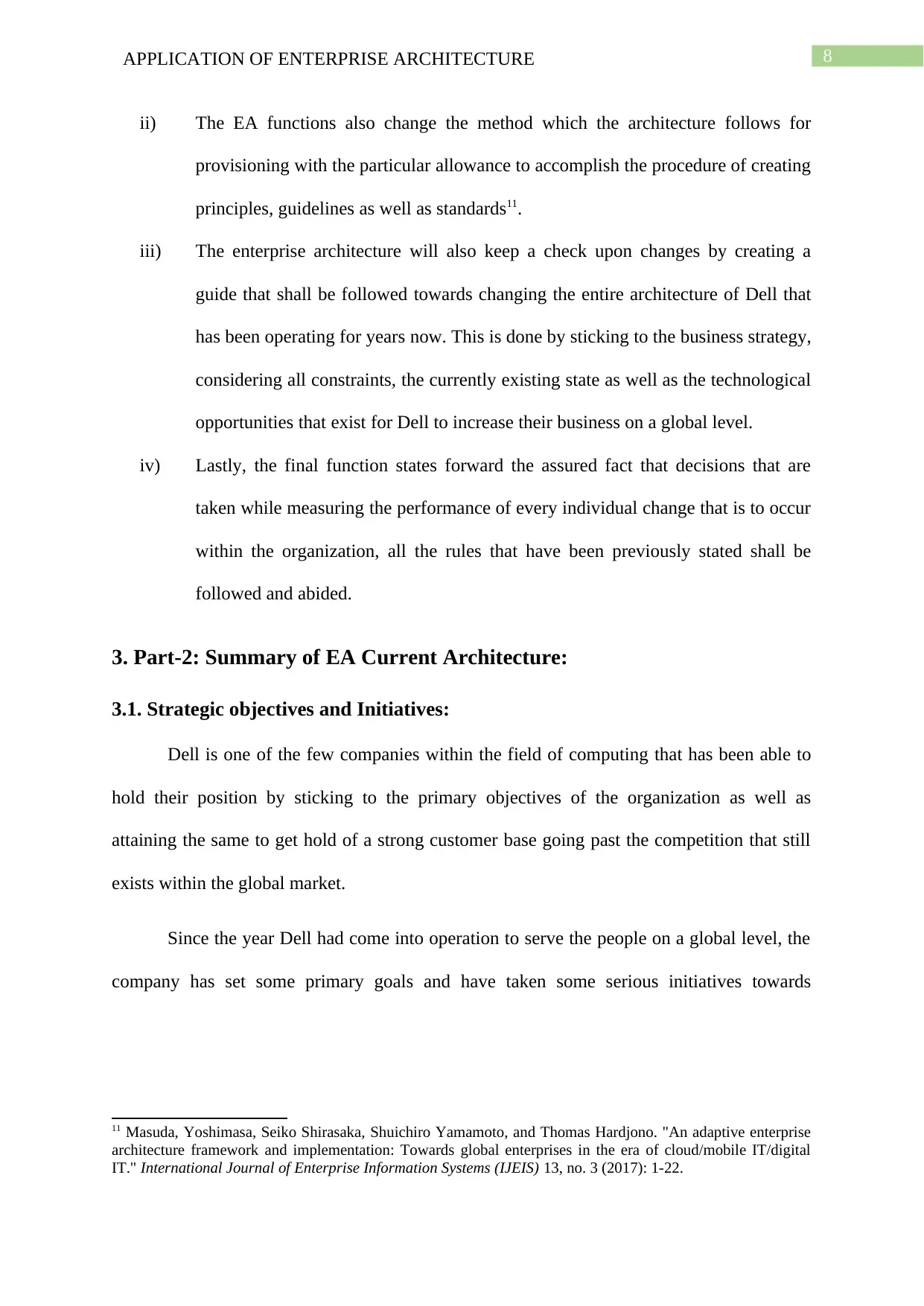
8APPLICATION OF ENTERPRISE ARCHITECTURE
ii) The EA functions also change the method which the architecture follows for
provisioning with the particular allowance to accomplish the procedure of creating
principles, guidelines as well as standards11.
iii) The enterprise architecture will also keep a check upon changes by creating a
guide that shall be followed towards changing the entire architecture of Dell that
has been operating for years now. This is done by sticking to the business strategy,
considering all constraints, the currently existing state as well as the technological
opportunities that exist for Dell to increase their business on a global level.
iv) Lastly, the final function states forward the assured fact that decisions that are
taken while measuring the performance of every individual change that is to occur
within the organization, all the rules that have been previously stated shall be
followed and abided.
3. Part-2: Summary of EA Current Architecture:
3.1. Strategic objectives and Initiatives:
Dell is one of the few companies within the field of computing that has been able to
hold their position by sticking to the primary objectives of the organization as well as
attaining the same to get hold of a strong customer base going past the competition that still
exists within the global market.
Since the year Dell had come into operation to serve the people on a global level, the
company has set some primary goals and have taken some serious initiatives towards
11 Masuda, Yoshimasa, Seiko Shirasaka, Shuichiro Yamamoto, and Thomas Hardjono. "An adaptive enterprise
architecture framework and implementation: Towards global enterprises in the era of cloud/mobile IT/digital
IT." International Journal of Enterprise Information Systems (IJEIS) 13, no. 3 (2017): 1-22.
ii) The EA functions also change the method which the architecture follows for
provisioning with the particular allowance to accomplish the procedure of creating
principles, guidelines as well as standards11.
iii) The enterprise architecture will also keep a check upon changes by creating a
guide that shall be followed towards changing the entire architecture of Dell that
has been operating for years now. This is done by sticking to the business strategy,
considering all constraints, the currently existing state as well as the technological
opportunities that exist for Dell to increase their business on a global level.
iv) Lastly, the final function states forward the assured fact that decisions that are
taken while measuring the performance of every individual change that is to occur
within the organization, all the rules that have been previously stated shall be
followed and abided.
3. Part-2: Summary of EA Current Architecture:
3.1. Strategic objectives and Initiatives:
Dell is one of the few companies within the field of computing that has been able to
hold their position by sticking to the primary objectives of the organization as well as
attaining the same to get hold of a strong customer base going past the competition that still
exists within the global market.
Since the year Dell had come into operation to serve the people on a global level, the
company has set some primary goals and have taken some serious initiatives towards
11 Masuda, Yoshimasa, Seiko Shirasaka, Shuichiro Yamamoto, and Thomas Hardjono. "An adaptive enterprise
architecture framework and implementation: Towards global enterprises in the era of cloud/mobile IT/digital
IT." International Journal of Enterprise Information Systems (IJEIS) 13, no. 3 (2017): 1-22.
⊘ This is a preview!⊘
Do you want full access?
Subscribe today to unlock all pages.

Trusted by 1+ million students worldwide
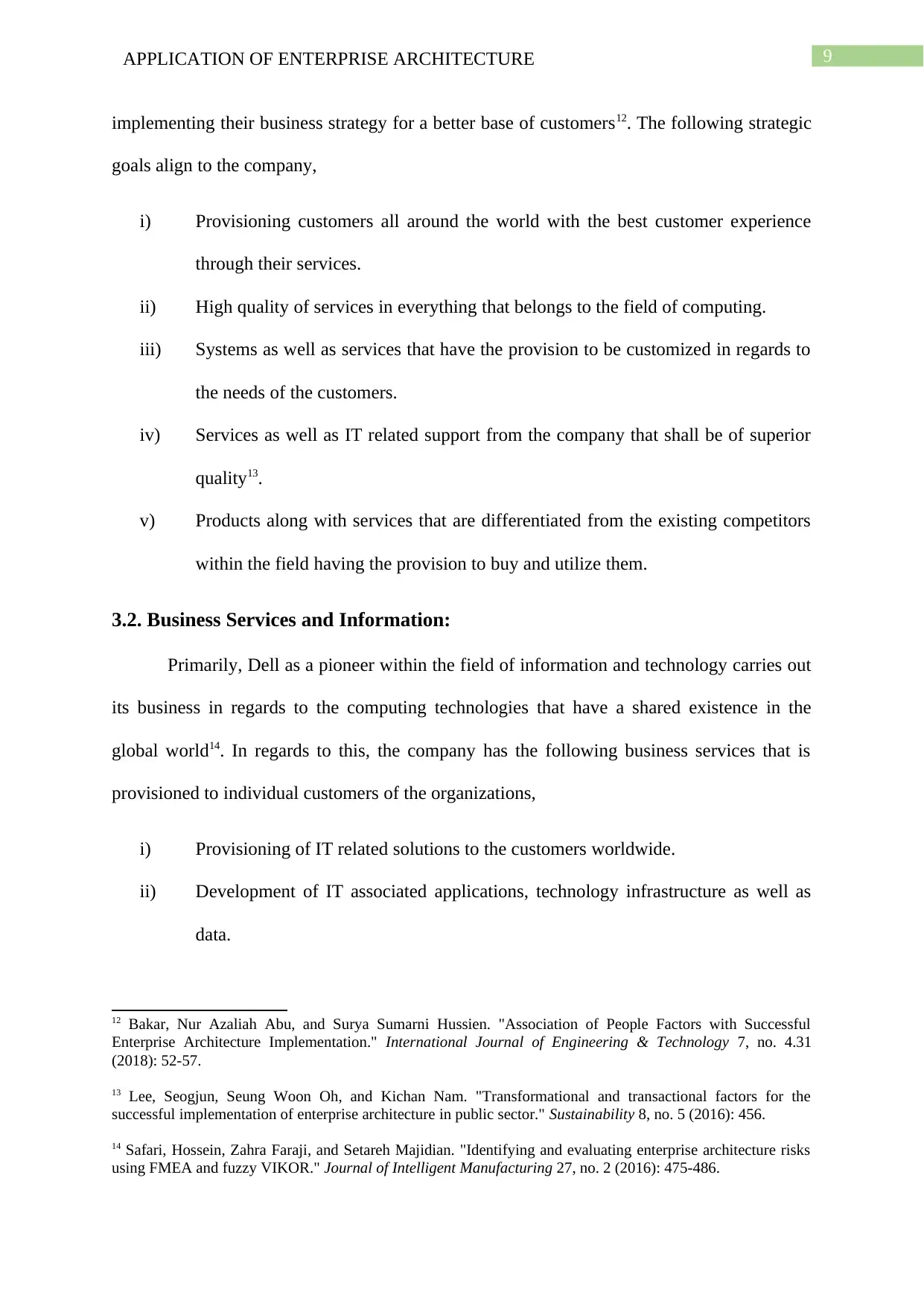
9APPLICATION OF ENTERPRISE ARCHITECTURE
implementing their business strategy for a better base of customers12. The following strategic
goals align to the company,
i) Provisioning customers all around the world with the best customer experience
through their services.
ii) High quality of services in everything that belongs to the field of computing.
iii) Systems as well as services that have the provision to be customized in regards to
the needs of the customers.
iv) Services as well as IT related support from the company that shall be of superior
quality13.
v) Products along with services that are differentiated from the existing competitors
within the field having the provision to buy and utilize them.
3.2. Business Services and Information:
Primarily, Dell as a pioneer within the field of information and technology carries out
its business in regards to the computing technologies that have a shared existence in the
global world14. In regards to this, the company has the following business services that is
provisioned to individual customers of the organizations,
i) Provisioning of IT related solutions to the customers worldwide.
ii) Development of IT associated applications, technology infrastructure as well as
data.
12 Bakar, Nur Azaliah Abu, and Surya Sumarni Hussien. "Association of People Factors with Successful
Enterprise Architecture Implementation." International Journal of Engineering & Technology 7, no. 4.31
(2018): 52-57.
13 Lee, Seogjun, Seung Woon Oh, and Kichan Nam. "Transformational and transactional factors for the
successful implementation of enterprise architecture in public sector." Sustainability 8, no. 5 (2016): 456.
14 Safari, Hossein, Zahra Faraji, and Setareh Majidian. "Identifying and evaluating enterprise architecture risks
using FMEA and fuzzy VIKOR." Journal of Intelligent Manufacturing 27, no. 2 (2016): 475-486.
implementing their business strategy for a better base of customers12. The following strategic
goals align to the company,
i) Provisioning customers all around the world with the best customer experience
through their services.
ii) High quality of services in everything that belongs to the field of computing.
iii) Systems as well as services that have the provision to be customized in regards to
the needs of the customers.
iv) Services as well as IT related support from the company that shall be of superior
quality13.
v) Products along with services that are differentiated from the existing competitors
within the field having the provision to buy and utilize them.
3.2. Business Services and Information:
Primarily, Dell as a pioneer within the field of information and technology carries out
its business in regards to the computing technologies that have a shared existence in the
global world14. In regards to this, the company has the following business services that is
provisioned to individual customers of the organizations,
i) Provisioning of IT related solutions to the customers worldwide.
ii) Development of IT associated applications, technology infrastructure as well as
data.
12 Bakar, Nur Azaliah Abu, and Surya Sumarni Hussien. "Association of People Factors with Successful
Enterprise Architecture Implementation." International Journal of Engineering & Technology 7, no. 4.31
(2018): 52-57.
13 Lee, Seogjun, Seung Woon Oh, and Kichan Nam. "Transformational and transactional factors for the
successful implementation of enterprise architecture in public sector." Sustainability 8, no. 5 (2016): 456.
14 Safari, Hossein, Zahra Faraji, and Setareh Majidian. "Identifying and evaluating enterprise architecture risks
using FMEA and fuzzy VIKOR." Journal of Intelligent Manufacturing 27, no. 2 (2016): 475-486.
Paraphrase This Document
Need a fresh take? Get an instant paraphrase of this document with our AI Paraphraser
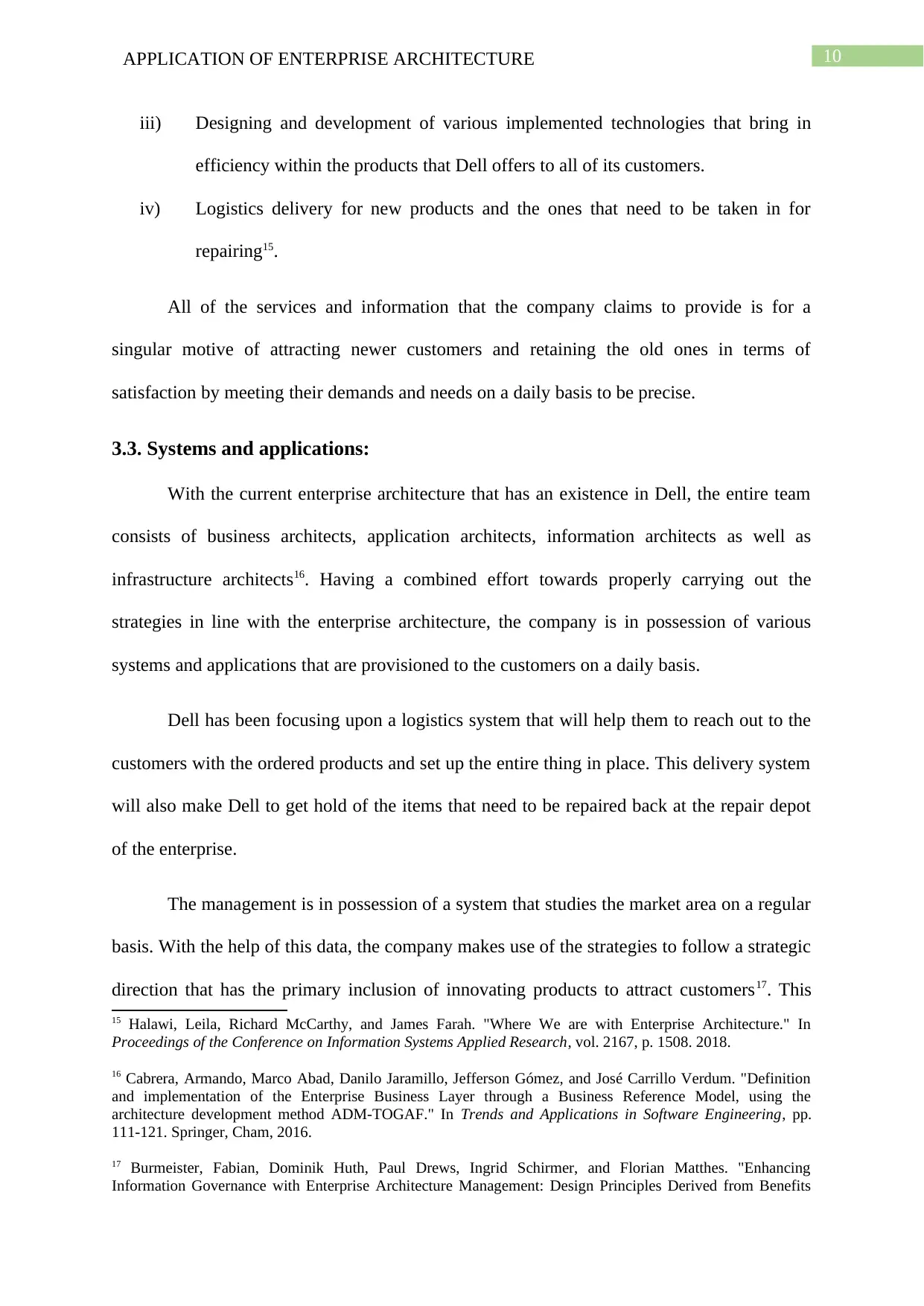
10APPLICATION OF ENTERPRISE ARCHITECTURE
iii) Designing and development of various implemented technologies that bring in
efficiency within the products that Dell offers to all of its customers.
iv) Logistics delivery for new products and the ones that need to be taken in for
repairing15.
All of the services and information that the company claims to provide is for a
singular motive of attracting newer customers and retaining the old ones in terms of
satisfaction by meeting their demands and needs on a daily basis to be precise.
3.3. Systems and applications:
With the current enterprise architecture that has an existence in Dell, the entire team
consists of business architects, application architects, information architects as well as
infrastructure architects16. Having a combined effort towards properly carrying out the
strategies in line with the enterprise architecture, the company is in possession of various
systems and applications that are provisioned to the customers on a daily basis.
Dell has been focusing upon a logistics system that will help them to reach out to the
customers with the ordered products and set up the entire thing in place. This delivery system
will also make Dell to get hold of the items that need to be repaired back at the repair depot
of the enterprise.
The management is in possession of a system that studies the market area on a regular
basis. With the help of this data, the company makes use of the strategies to follow a strategic
direction that has the primary inclusion of innovating products to attract customers17. This
15 Halawi, Leila, Richard McCarthy, and James Farah. "Where We are with Enterprise Architecture." In
Proceedings of the Conference on Information Systems Applied Research, vol. 2167, p. 1508. 2018.
16 Cabrera, Armando, Marco Abad, Danilo Jaramillo, Jefferson Gómez, and José Carrillo Verdum. "Definition
and implementation of the Enterprise Business Layer through a Business Reference Model, using the
architecture development method ADM-TOGAF." In Trends and Applications in Software Engineering, pp.
111-121. Springer, Cham, 2016.
17 Burmeister, Fabian, Dominik Huth, Paul Drews, Ingrid Schirmer, and Florian Matthes. "Enhancing
Information Governance with Enterprise Architecture Management: Design Principles Derived from Benefits
iii) Designing and development of various implemented technologies that bring in
efficiency within the products that Dell offers to all of its customers.
iv) Logistics delivery for new products and the ones that need to be taken in for
repairing15.
All of the services and information that the company claims to provide is for a
singular motive of attracting newer customers and retaining the old ones in terms of
satisfaction by meeting their demands and needs on a daily basis to be precise.
3.3. Systems and applications:
With the current enterprise architecture that has an existence in Dell, the entire team
consists of business architects, application architects, information architects as well as
infrastructure architects16. Having a combined effort towards properly carrying out the
strategies in line with the enterprise architecture, the company is in possession of various
systems and applications that are provisioned to the customers on a daily basis.
Dell has been focusing upon a logistics system that will help them to reach out to the
customers with the ordered products and set up the entire thing in place. This delivery system
will also make Dell to get hold of the items that need to be repaired back at the repair depot
of the enterprise.
The management is in possession of a system that studies the market area on a regular
basis. With the help of this data, the company makes use of the strategies to follow a strategic
direction that has the primary inclusion of innovating products to attract customers17. This
15 Halawi, Leila, Richard McCarthy, and James Farah. "Where We are with Enterprise Architecture." In
Proceedings of the Conference on Information Systems Applied Research, vol. 2167, p. 1508. 2018.
16 Cabrera, Armando, Marco Abad, Danilo Jaramillo, Jefferson Gómez, and José Carrillo Verdum. "Definition
and implementation of the Enterprise Business Layer through a Business Reference Model, using the
architecture development method ADM-TOGAF." In Trends and Applications in Software Engineering, pp.
111-121. Springer, Cham, 2016.
17 Burmeister, Fabian, Dominik Huth, Paul Drews, Ingrid Schirmer, and Florian Matthes. "Enhancing
Information Governance with Enterprise Architecture Management: Design Principles Derived from Benefits
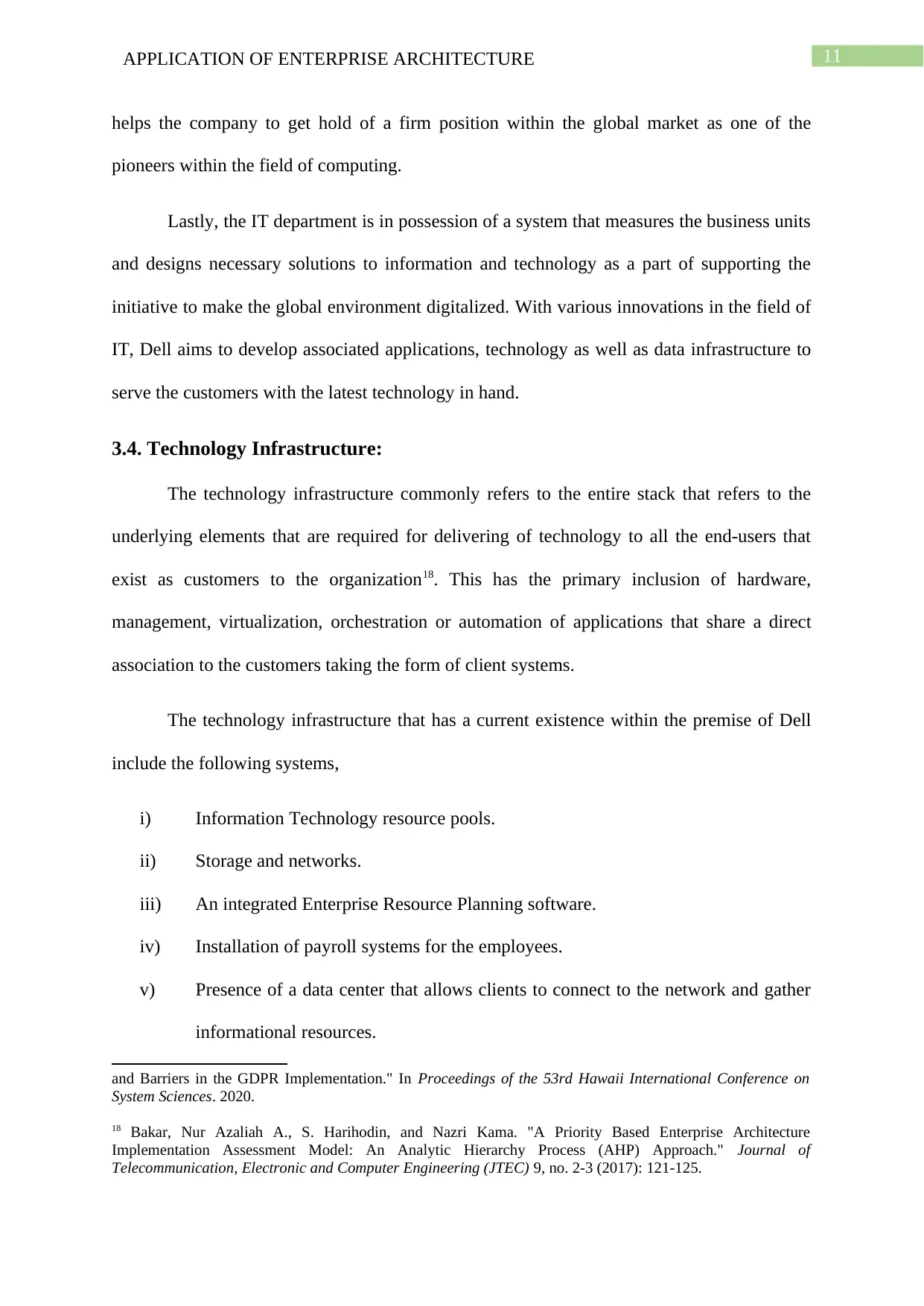
11APPLICATION OF ENTERPRISE ARCHITECTURE
helps the company to get hold of a firm position within the global market as one of the
pioneers within the field of computing.
Lastly, the IT department is in possession of a system that measures the business units
and designs necessary solutions to information and technology as a part of supporting the
initiative to make the global environment digitalized. With various innovations in the field of
IT, Dell aims to develop associated applications, technology as well as data infrastructure to
serve the customers with the latest technology in hand.
3.4. Technology Infrastructure:
The technology infrastructure commonly refers to the entire stack that refers to the
underlying elements that are required for delivering of technology to all the end-users that
exist as customers to the organization18. This has the primary inclusion of hardware,
management, virtualization, orchestration or automation of applications that share a direct
association to the customers taking the form of client systems.
The technology infrastructure that has a current existence within the premise of Dell
include the following systems,
i) Information Technology resource pools.
ii) Storage and networks.
iii) An integrated Enterprise Resource Planning software.
iv) Installation of payroll systems for the employees.
v) Presence of a data center that allows clients to connect to the network and gather
informational resources.
and Barriers in the GDPR Implementation." In Proceedings of the 53rd Hawaii International Conference on
System Sciences. 2020.
18 Bakar, Nur Azaliah A., S. Harihodin, and Nazri Kama. "A Priority Based Enterprise Architecture
Implementation Assessment Model: An Analytic Hierarchy Process (AHP) Approach." Journal of
Telecommunication, Electronic and Computer Engineering (JTEC) 9, no. 2-3 (2017): 121-125.
helps the company to get hold of a firm position within the global market as one of the
pioneers within the field of computing.
Lastly, the IT department is in possession of a system that measures the business units
and designs necessary solutions to information and technology as a part of supporting the
initiative to make the global environment digitalized. With various innovations in the field of
IT, Dell aims to develop associated applications, technology as well as data infrastructure to
serve the customers with the latest technology in hand.
3.4. Technology Infrastructure:
The technology infrastructure commonly refers to the entire stack that refers to the
underlying elements that are required for delivering of technology to all the end-users that
exist as customers to the organization18. This has the primary inclusion of hardware,
management, virtualization, orchestration or automation of applications that share a direct
association to the customers taking the form of client systems.
The technology infrastructure that has a current existence within the premise of Dell
include the following systems,
i) Information Technology resource pools.
ii) Storage and networks.
iii) An integrated Enterprise Resource Planning software.
iv) Installation of payroll systems for the employees.
v) Presence of a data center that allows clients to connect to the network and gather
informational resources.
and Barriers in the GDPR Implementation." In Proceedings of the 53rd Hawaii International Conference on
System Sciences. 2020.
18 Bakar, Nur Azaliah A., S. Harihodin, and Nazri Kama. "A Priority Based Enterprise Architecture
Implementation Assessment Model: An Analytic Hierarchy Process (AHP) Approach." Journal of
Telecommunication, Electronic and Computer Engineering (JTEC) 9, no. 2-3 (2017): 121-125.
⊘ This is a preview!⊘
Do you want full access?
Subscribe today to unlock all pages.

Trusted by 1+ million students worldwide
1 out of 25
Related Documents
Your All-in-One AI-Powered Toolkit for Academic Success.
+13062052269
info@desklib.com
Available 24*7 on WhatsApp / Email
![[object Object]](/_next/static/media/star-bottom.7253800d.svg)
Unlock your academic potential
Copyright © 2020–2025 A2Z Services. All Rights Reserved. Developed and managed by ZUCOL.



